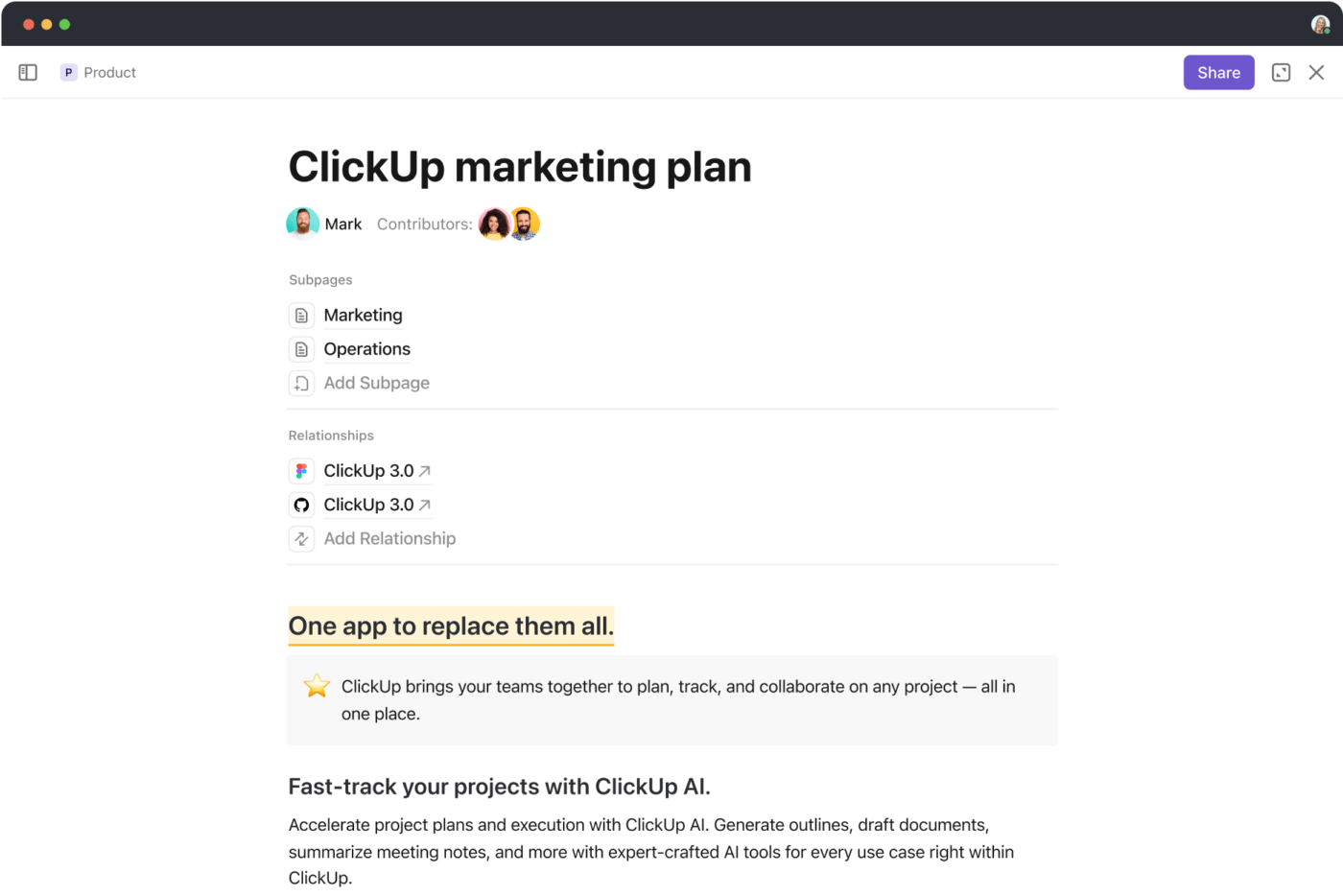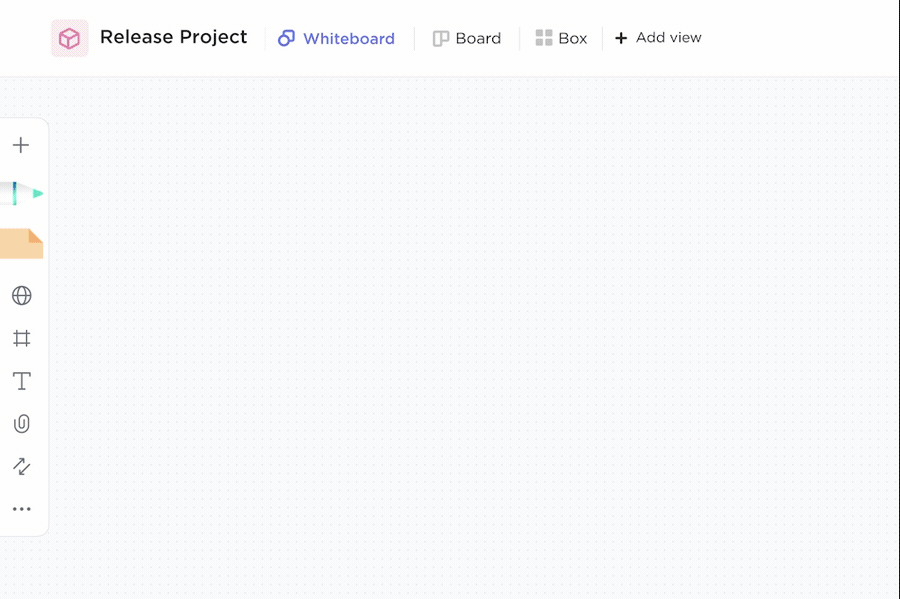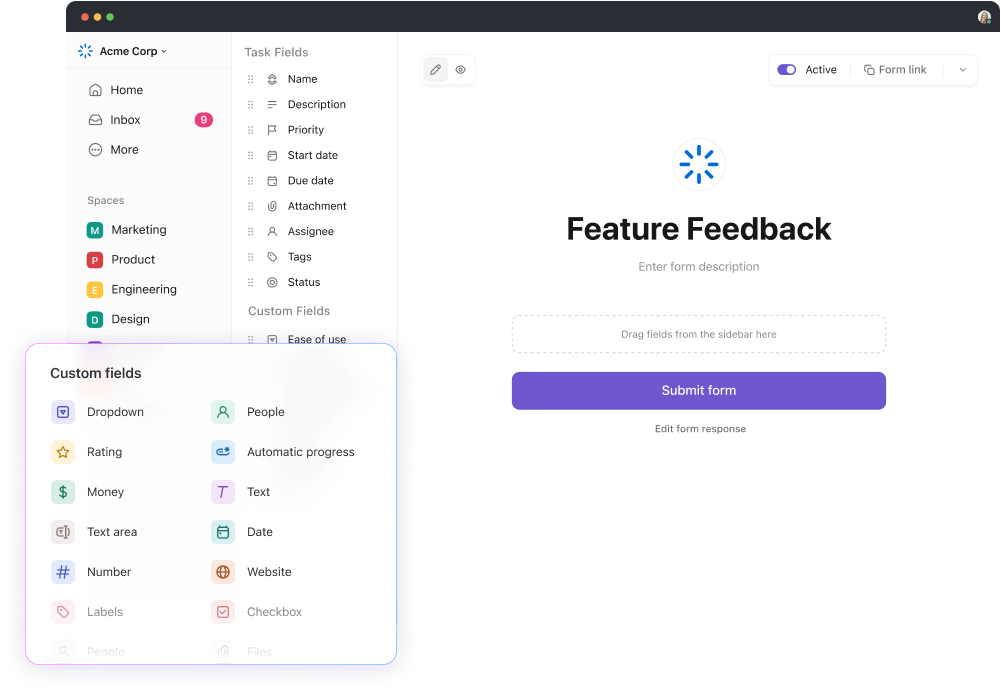سواءً كان الأمر يتعلق بفهم عمليات التطوير، أو فك رموز كيفية تثبيت برامج الكمبيوتر، أو معرفة خطط بناء منتج جديد، فإن التوثيق الفني يساعد الأشخاص على إنجاز المهمة.
ولكن كيف تضمن أنك تقوم بصياغة وثائق تقنية جيدة؟
لحسن الحظ، هذا ما نحن هنا للإجابة عليه. 🤩
على الرغم من أن الوثائق التقنية لا تتمتع بسمعة براقة أو مثيرة للاهتمام، إلا أن هذا لا يعني أنه لا يمكنك الاستمتاع قليلاً في إعدادها.
في الواقع، تُعد صياغة الوثائق الفنية فرصة ممتازة لوضع قبعة التفكير الإبداعي الخاصة بك، والترابط مع الزملاء، وتقديم معلومات حيوية للقراء، مما يضيف هدفًا إلى مساعيك.
مع وضع ذلك في الاعتبار، دعنا نتعمق أكثر في التوثيق الفني، بما في ذلك فوائده وأفضل الممارسات. كما سنستعرض أيضًا عملية الإنشاء خطوة بخطوة حتى تعرف كيف تكتب وثائق تقنية تتألق. ✨
(المكافأة: سنكشف أيضًا عن مساعد الذكاء الاصطناعي الذي يمكنه تسريع العملية!)
ما هي الوثائق التقنية؟
التوثيق الفني هو مورد مكتوب يوضح وظائف وميزات المنتج أو الأداة. قد يركز هذا النوع من الكتابة الفنية على بنية التصميم أو إجراءات التشغيل القياسية (SOPs) أو الأدلة الإرشادية أو حالات الاستخدام أو الأدلة الإرشادية. 🛠️
تختلف الوثائق التقنية بشكل كبير حسب الموضوع والجمهور المستهدف. على عكس مقترحات الأعمال أو خطط العمل أو النشرات الصحفية، تركز الوثائق التقنية على (كما خمنت) المواضيع التقنية.
أنشئ مستندًا جديدًا من أي مكان في مساحة عمل ClickUp الخاصة بك
بعض المستندات الفنية مخصصة للاستخدام الداخلي لوضع عمليات التطوير وأفضل الممارسات لتطوير الأدوات وإضافة ميزات جديدة. ويستخدم كتّاب تقنيون آخرون هذا النوع من الوثائق لمساعدة المستخدم على التنقل بين المنتجات الجديدة واكتشاف طرق جديدة لاستخدامها.
سينشئ معظم المطورين والمصممين عشرات الأنواع المختلفة من الوثائق الفنية خلال دورة حياة تطوير البرمجيات (SDLC). بشكل عام، يتم كتابة هذا النوع من الوثائق بواسطة كتّاب تقنيين.
ومع ذلك، غالبًا ما يقوم مهندسو البرمجيات والخبراء المتخصصون (SMEs) وأعضاء فريق منتج البرمجيات المبتدئين بإنشاء وثائق تقنية كجزء من قوائم مهامهم اليومية. سواء كنت محترفاً أو بدأت للتو، هناك العديد من الفوائد لكتابة الوثائق التقنية.
ما أهمية كتابة الوثائق التقنية؟
التوثيق التقني هو أداة أساسية لمساعدة الناس على فهم منتجاتك وخدماتك وعملياتك. فهي لا تساعد المستخدمين فحسب، بل تتيح لك أيضًا بناء فريق عمل أفضل وأكثر كفاءة. فيما يلي بعض الأسباب التي تجعل التوثيق التقني أمرًا بالغ الأهمية لنجاحك. 💪
تمكنك من اتخاذ قرارات أفضل
تساعد الوثائق الفنية الفريق على فهم كيفية عمل أداة معينة. عندما يحين وقت إضافة ميزات جديدة، يمكنهم بسهولة الرجوع إلى المستندات الفنية الداخلية لمعرفة الإجراءات.
توفر هذه المستندات قاعدة بيانات مركزية للمعلومات، مما يضمن عدم ضياع المطورين في البحث في رسائل البريد الإلكتروني أو المحادثات للعثور على التفاصيل التي يحتاجون إليها.
يحسن تجربة المستخدم
تؤدي مهارات الكتابة التقنية الممتازة إلى مستندات غنية بالمعلومات التي تبسط تجربة المستخدم. يضيف العديد من المطوّرين مستندات تقنية أو وثائق المشروع في التطبيق أو المنتج مباشرةً حتى لا يضطر المستخدمون إلى تبديل الشاشات للحصول على المساعدة.

تعاون في الوقت الفعلي واحتفظ ببياناتك مخزنة بأمان في مكان واحد مع ClickUp Docs
بالإضافة إلى المحتوى التقني المكتوب، تضيف العناصر المرئية مثل الرسوم البيانية والعناوين الواضحة والرسوم البيانية سياقاً جديداً. وهذا يعني أن المستخدمين الذين لديهم معرفة تقنية أقل لا يزالون يحصلون على أقصى استفادة من منتجاتك.
يقلل الضغط على فرق دعم العملاء
من خلال الوثائق التقنية المنظمة والمدروسة والمنفذة بشكل جيد، لن يواجه فريق الدعم الخاص بك متاعب الاستفسارات المكررة من العملاء. عندما تقوم بشرح المعلومات المعقدة في أدلة إرشادية وأسئلة شائعة سهلة الاستخدام، يتم تمكين العملاء من الحصول على إجابات لأسئلتهم واستكشاف المشكلات البسيطة وإصلاحها بأنفسهم.
أخطاء أقل وتعليم أفضل
عندما تقوم بتوثيق العمليات والميزات التقنية، تقل فرصة ارتكاب الأخطاء لأن لديك مصدرًا واحدًا للحقيقة. بالإضافة إلى ذلك، من الأسهل تدريب المستخدمين وأصحاب المصلحة وأعضاء الفريق عندما يكون لديك وثائق تقنية جيدة جاهزة.
وهذا يعني المزيد من الوقت للابتكار وصياغة أفكار جديدة. 💡
يقدم طريقة لتخزين الأفكار
تخلق الوثائق الفنية خارطة طريق للأفكار المستقبلية وتوثق أيضًا المشاريع السابقة في مكان واحد يسهل العثور عليه. يمكنك بسهولة الرجوع إلى المستندات السابقة لمعرفة ما تم العمل عليه واكتساب رؤى للتكرارات المستقبلية.

قم بتخصيص اللوحات البيضاء بسهولة عن طريق إضافة المستندات والمهام والمزيد
بعبارة أخرى، تساعدك المستندات الفنية المناسبة على بناء خرائط طريق للمنتج لتصور عروضك المستقبلية مع فهم ما وصلت إليه الأمور اليوم. إنها الأداة المثالية لوضع الإجراءات مع تشجيع الابتكار والإبداع في الوقت نفسه.
تزيد من التواصل
إن إنشاء الوثائق التقنية بطبيعته جهد تعاوني. وهذا يعني أنه يعزز التواصل ويبني الروابط عبر الفريق. يجب أن يعمل الجميع معًا لإنشاء قطعة غنية بالمعلومات ومفيدة - ووجهات النظر المختلفة تضفي رؤى أفضل. 🤝
مع وجود وثائق داخلية قوية، يمكن لأعضاء الفريق العمل بكفاءة أكبر بمفردهم. فهم قادرون على الرجوع إلى الوثائق الموجودة للإجابة على الأسئلة ويمكنهم الوصول إلى الموارد لبناء ميزات جديدة.
يعزز الأمان
تضع الوثائق التقنية الداخلية الأساس لتحسين الأمن والامتثال للهيئات التنظيمية. سلّط الضوء في مستنداتك على إجراءات الأمان وأفضل الممارسات لإنشاء ميزات جديدة ومشاركة الوثائق مع الجمهور.
النوعان الرئيسيان للتوثيق التقني ## النوعان الرئيسيان للتوثيق التقني
هناك عدة أنواع مختلفة من الكتابة التقنية والتوثيق ولكن معظمها ينقسم إلى فئتين متميزتين: توثيق المنتج أو توثيق العمليات. 📃
توثيق المنتج
وثائق المنتج هي كل ما يتعلق بالمنتج نفسه بما في ذلك الميزات الرئيسية والوظائف والتعليمات خطوة بخطوة حول كيفية استخدامه. المثال الأكثر شيوعًا لوثائق المنتج هو أدلة تجربة المستخدم (UX) حول كيفية استخدام برنامج أو أداة معينة.
مثال آخر على وثائق المنتج هو دليل الإصلاح الذي يشرح كيفية إصلاح المشكلات المتعلقة بالمنتج نفسه. يمكن تقسيم هذه الفئة بشكل أكبر للتركيز على وثائق المنتج الخاصة بالنظام، والتي تهدف إلى إعلام فرق تطوير المنتج والمصنعين، ووثائق المستخدم لمساعدة العميل على التنقل في المنتج.
تشمل أنواع وثائق المنتجات التقنية ما يلي:
- تصميم تجربة المستخدم بما في ذلك أدلة أنماط تجربة المستخدم وشخصيات المستخدمين
- أوراق متطلبات المنتج
- أوصاف المنتج
- وثائق واجهة برمجة التطبيقات
- وثائق التعليمات البرمجية المصدرية
- تحديثات الميزات
- أدلة المستخدم النهائي، بما في ذلك الأسئلة الشائعة وملاحظات الإصدار والأدلة الإرشادية والبرامج التعليمية التدريبية
- التصميم التقني/الهندسة المعمارية
- كتيبات المستخدم مثل الأدلة الإرشادية وأدلة التعليمات وأدلة التثبيت
وثائق العملية وثائق العملية هي أكثر من وثيقة فنية من وراء الكواليس. تهدف هذه المستندات إلى وضع أو شرح العمليات والإجراءات المستخدمة لإنشاء المنتجات. تتضمن وثائق العمليات أشياء مثل خطط المشروع وخطط الاختبار وأدلة استكشاف الأخطاء وإصلاحها الداخلية. 🎯
الجمهور المستهدف لوثائق العمليات هم مطورو ومصممو المنتجات والبرمجيات. تهدف هذه المستندات إلى الإجابة عن الأسئلة الشائعة، ووضع خرائط طريق لبناء الأداة، وتقديم توضيحات.
ومن أمثلة وثائق العمليات ما يلي:
- جداول الاختبارات
- إجراءات التشغيل الموحدة لسير عمل التطوير
- الأوراق البيضاء ودراسات الحالة
- خطط المشاريع
- خرائط طريق المنتج
كيفية كتابة الوثائق الفنية
هل أنت مستعد لكتابة وثائق تقنية أفضل وإنشاء مسودات تجعل فريقك أكثر كفاءة؟ إليك كيفية كتابة الوثائق التقنية باستخدام البرامج و أدوات الكتابة مثل ClickUp Docs ومساعد الكتابة بالذكاء الاصطناعي من ClickUp. ✍️
1. قم بتحليل وتحديد من هم جمهورك لإنشاء محتوى مستهدف
قبل البدء في الكتابة، عليك أن تعرف لمن تكتب. سيكون الصوت والنبرة وأسلوب الكتابة الذي تستخدمه مختلفًا إذا كنت تنشئ وثائق للجمهور العام مقابل مواد قاعدة المعرفة الداخلية.
اسأل نفسك من هم جمهورك وما هو أسلوبهم في التعلم. فكر في أنواع الأسئلة التي قد تكون لديهم وما يحتاجون إليه من وثائقك.

قم بسحب وإسقاط الأشكال على اللوحة القماشية الخاصة بك، وربط سير عملك معًا، والعمل مع فريقك في نفس الوقت في ClickUp Whiteboard ClickUp Whiteboards هي المكان الذي يمكنك فيه تدوين الأفكار والعصف الذهني. استخدم وظيفة السحب والإفلات والاستفادة من التعاون في الوقت الفعلي حتى تتمكن من جعل الفريق بأكمله يطرح الأفكار معًا.
والأفضل من ذلك كله، يمكنك إنشاء المهام مباشرةً على اللوحة حتى تتمكن من الانتقال بسلاسة إلى الخطوة التالية من عملية التوثيق الفني. 🌻
2. ابحث عن الموضوعات التي ستجذب القراء وتمنحهم الإجابات التي يحتاجون إليها
بعد ذلك، تحتاج إلى البحث في المواضيع. ففي النهاية، لن تعرف كيفية إنشاء وثائق تقنية إذا كنت لا تعرف ما الذي تحاول قوله.
فكر في الهدف من وثائقك الفنية. اعمل بشكل عكسي من هناك مع الأخذ في الاعتبار ما تريد تضمينه وما هي المستندات التي قد تكون لديك بالفعل والتي ستكون مفيدة.
إذا كنت عالقًا وتحتاج إلى مساعدة في الخروج بأفكار، فلا يمكنك أن تخطئ في ClickUp AI هو المساعد الوحيد المدعوم بالذكاء الاصطناعي المصمم خصيصاً لدورك. مع العشرات من حالات الاستخدام، فهو المساعد المثالي لتوليد الأفكار والخروج بمواضيع ذات صلة.

يمكنك أتمتة كتابة الوثائق باستخدام الذكاء الاصطناعي، ومراقبة التقدم المحرز من خلال المخططات والسباقات السريعة وحل أخطاء الترميز بسرعة باستخدام ClickUp
اجعل الفريق بأكمله يشارك في العمل و تعيين مهام ClickUp من أجل العصف الذهني والبحث عن الموضوع وما بعده. مع وجود عدد أكبر من الرؤساء الذين يعالجون نفس المشروع، من المؤكد أنك ستصل إلى جميع القواعد وتنشئ وثائق ستبهر (وتساعد) جمهورك.
3. اختر أفضل نوع توثيق وإطار عمل للمعلومات التي تريد مشاركتها
مع وضع قارئك في الاعتبار، ناقش نوع التوثيق التقني الفعال الأكثر منطقية. ربما تكتب دليل تثبيت يوضح كيفية إعداد منتجك. أو ربما تقوم بإنشاء إجراءات تشغيل موحدة لإضافة ميزات جديدة أو الاستفادة من واجهة برمجة التطبيقات.
أيًا كان المستند التقني الذي تقوم بصياغته، استخدم انقر فوق المستندات لإنشاء إطار العمل. هذه المستندات القابلة للتخصيص حيث يمكنك التعاون وإضافة الأقسام والجداول وتضمين الروابط والصور بنقرة بالماوس. 🖱️

الكشف التعاوني والتحرير التعاوني وإضافة التعليقات وتضمين الروابط داخل مستندات ClickUp Docs
والأكثر من ذلك، مدمج في أدوات كتابة الذكاء الاصطناعي تتيح لك إنشاء مستندات في جزء صغير من الوقت. تساعدك القوائم المنسدلة التي تحتوي على اقتراحات في إنهاء جُملك، وتغيير أنظمة الألوان، وتحديث الطباعة، وغير ذلك الكثير.
تساعدك قوالب ClickUp أيضًا على البدء في إنشاء مجموعة كبيرة من المستندات التقنية. موارد مثل قوالب إجراءات التشغيل الموحدة , قوالب صفحة غلاف التقرير الفني و قوالب تقارير الأخطاء قم على الفور ببناء إطار عمل حيث عليك ببساطة ملء التفاصيل الخاصة بك.
4. قم بإنشاء بنية محتوى يسهل مسحها ضوئيًا وتنظيم المعلومات
ضع في اعتبارك كيف سيفهم المستخدمون منتجاتك أو خدماتك على أفضل وجه واجعلها توجه تصميم وثائقك الفنية.
على سبيل المثال، هل قراؤك متعلمون بصريون؟ هل ستعمل الرسوم البيانية والمخططات وغيرها من الوسائل البصرية على تحسين تجربة المستخدم؟ تكاملات ClickUp مع أدوات مثل Github تجعل من السهل إضافة عناصر مرئية لدعم المحتوى المكتوب مباشرةً من مساحات عمل البرنامج.
اجعل المستند الخاص بك سهل المسح الضوئي حتى يتمكن القراء من العثور على المعلومات الدقيقة التي يبحثون عنها. يقطع جدول المحتويات شوطًا طويلاً في إثبات الوضوح، خاصةً عندما يتعلق الأمر بالأدلة الإرشادية الأطول. 👀

تتيح لك ميزات إعادة كتابة المدونة باستخدام ClickUp AI إعادة كتابة كميات كبيرة من المحتوى لتتناسب مع نبرة صوتك المحددة برنامج مساعد الكتابة والأدوات التي تخلصك من التخمين في بناء هيكل مستندك من الصفر. احصل على الدعم الإملائي والنحوي، وأعد كتابة أجزاء كبيرة من النص، واستفد من العناوين والملخصات التي يتم إنشاؤها تلقائيًا بناءً على المطالبات.
5. احصل على تعليقات من زملائك في الفريق ومجموعات الاختبار
تبدأ الوثائق التقنية الرائعة بمسودة أولى، لكنها لا تنتهي عند هذا الحد. فهي تتضمن العديد من التكرارات والكثير من الضبط الدقيق.
قم بجدولة محادثات مع أعضاء الفريق المعينين لتقييم التقدم المحرز وتحديد مجالات التحسين. قد يشيرون إلى الأفكار أو الميزات التي ربما فاتتك.

قم بسحب وإسقاط الحقول المخصصة في طريقة عرض النموذج لصياغة استطلاعات شاملة أو جمع الملاحظات في ClickUp 3.0
اطلب منهم تدوين الملاحظات وإضافة اقتراحات وطرح أسئلة مباشرة في المستند. قم بإجراء التغييرات واستمر في تنقيح المحتوى حتى يصبح مثاليًا. 🏅
عندما يتعلق الأمر بالتحرير، من المهم الحصول على مراجعات حول مهاراتك في الكتابة بالإضافة إلى الجوانب الفنية للمستند. يجب أن يراقب المراجعون سهولة الاستخدام، وسهولة القراءة، وسهولة الفهم.
6. نشر المحتوى وأتمتة عناصر العمل لتحديثه حسب الحاجة
بمجرد اجتياز المراجعة المتعمقة، يصبح المحتوى الخاص بك جاهزًا للنشر. تكمن فائدة استخدام ClickUp Docs في سهولة المشاركة بفضل الأذونات القابلة للتخصيص.
إنشاء أذونات عرض محدودة للداخلية وثائق البرامج أو افتحه للوصول العام إذا كنت تقوم بصياغة مواد المستخدم النهائي.

اطلع على أكثر من 15 طريقة عرض في ClickUp لتخصيص سير عملك وفقًا لاحتياجاتك
قم بجدولة مهام المراجعة كجزء من مهام سير عملك لتحديث المحتوى حسب الحاجة. استخدم الجداول الزمنية وعروض التقويم لمعرفة متى تم نشر المحتوى وجدولة المراجعات لضمان ملاءمة المعلومات وتحديثها.
باستخدام ClickUp، يمكنك تشغيل إشعار تلقائياً كلما تمت إضافة ميزة جديدة. أنشئ على الفور مهمة جديدة لتحديث وثائقك الفنية وأسندها إلى عضو الفريق المناسب.
لقد حان الوقت لإنشاء وثائق تقنية رائعة
التوثيق الفني الفعال هو شكل من أشكال التواصل الذي يساعد القراء على فهم منتجاتك بشكل أفضل ويسهل على فرق تطوير البرمجيات الابتكار والتصميم.
إذا كنت مستعدًا لرفع مستوى مهاراتك في الكتابة التقنية وإنشاء وثائق تقنية سيحبها قراؤك, اشترك في ClickUp اليوم 🏆
من صياغة المحتوى الفعلي إلى تشغيل المهام والتعاون مع الزملاء، إنها أداة شاملة ستجعل مهام الكتابة التقنية (وكل شيء آخر) تبدو سهلة للغاية.

